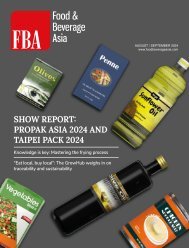Dental Asia May/June 2020
For more than two decades, Dental Asia is the premium journal in linking dental innovators and manufacturers to its rightful audience. We devote ourselves in showcasing the latest dental technology and share evidence-based clinical philosophies to serve as an educational platform to dental professionals. Our combined portfolio of print and digital media also allows us to reach a wider market and secure our position as the leading dental media in the Asia Pacific region while facilitating global interactions among our readers.
For more than two decades, Dental Asia is the premium journal in linking dental innovators
and manufacturers to its rightful audience. We devote ourselves in showcasing the latest dental technology and share evidence-based clinical philosophies to serve as an educational platform to dental professionals. Our combined portfolio of print and digital media also allows us to reach a wider market and secure our position as the leading dental media in the Asia Pacific region while facilitating global interactions among our readers.
You also want an ePaper? Increase the reach of your titles
YUMPU automatically turns print PDFs into web optimized ePapers that Google loves.
Clinical Feature<br />
common and are in close contact with<br />
staff. Disinfection of the whole dental<br />
practice to eliminate any droplets and<br />
aerosols contamination are most essential.<br />
COVID-19 can cause infection after twohour<br />
exposures on surfaces and last for nine<br />
days, surviving at 50% relative humidity.<br />
Therefore, it is suggested that a clean and<br />
dry environment in the dental office would<br />
help decrease the persistence of the virus 1, 8, 9 .<br />
Infection control strategies<br />
In order to intercept the infection of<br />
COVID-2019, dentists should have a<br />
better understanding of the virus on its<br />
transmission routes, as well as the protocol<br />
to stopping its spread in the dental office 9 .<br />
1. Identify patients with possible<br />
COVID-2019 infection.<br />
2. All patients must record their body<br />
temperatures before entering treatment,<br />
and fill up a form on their past travel history.<br />
3. Extra protective measures should be<br />
applied to all dental operations. These<br />
include infection control measures that<br />
should be followed by all operators and<br />
staff. Our recommendations are based<br />
on the WHO, CDC Guideline for Infection<br />
Control and the Diagnosis and Treatment<br />
of Coronavirus.<br />
4. It is rare to encounter confirmed COVID-19<br />
patients in general dental offices, since most<br />
of these patients will be under hospital care<br />
until they are tested negative. For patients<br />
with symptoms, seeking dental treatment<br />
is not recommended. Analgesics to prevent<br />
severe pain seems to be the only available<br />
solution, until the patient has been tested<br />
negative.<br />
Non-urgent or elective dental procedures,<br />
particularly those which will generate<br />
aerosols, should be delayed.<br />
5. A 20-second pre-procedural mouth<br />
rinse with either of the following is also<br />
recommended:<br />
• 1% hydrogen peroxide<br />
• 0.2% povidone iodine<br />
• 0.2% chlorhexidine rinse (alcohol free)<br />
• an essential oil mouth rinse (alcohol free) 3 .<br />
6. The following websites are recommended<br />
by different well-known organisations for<br />
dental practitioners for references:<br />
I. WHO (2003a) Practical Guidelines for<br />
Infection Control in Health Care Facilities.<br />
Geneva, Switzerland: WHO.<br />
http://www.wpro.who.int/sars/docs/<br />
practicalguidelines/practical_guidelines.<br />
pdf, accessed 2 August 2004.<br />
II. The concept of ‘Standard Precautions’<br />
which, as defined by the CDC, are a set<br />
of safety measures designed to prevent<br />
transmission of blood-borne infectious<br />
agents, human immunodeficiency virus<br />
(HIV) and hepatitis B virus (HBV). CDC<br />
(2003a) Guidelines for infection control in<br />
dental healthcare settings - 2003. MMWR<br />
52 (No. RR-17).<br />
ADA Interim Guidance for Minimising Risk of<br />
COVID19 Transmission<br />
https://www.ada.org.au/Campaign/<br />
COVID-19<br />
https://www.ada.org/en/publications/adanews/<strong>2020</strong>-archive/february/ada-releasescoronavirus-handout-for-dentists-basedon-cdc-guidelines<br />
https://www.cdc.gov/coronavirus/2019-<br />
ncov/infection-control/controlrecommendations.html?CDC_AA_<br />
refVal=https%3A%2F%2Fwww.<br />
cdc.gov%2Fcoronavirus%2F2019-<br />
ncov%2Fhcp%2Finfection-control.html<br />
III. United Kingdom Department of Health.<br />
NHS HTM 01-05: Decontamination in<br />
primary care dental practices. 2013 Version.<br />
https://www.chp.gov.hk/files/pdf/the_<br />
basic_protocol_ic_guidelines_for_the_<br />
dental_service_dh.pdf<br />
Personal Protective Equipment (PPE)<br />
The operator and staff should be well<br />
protected with surgical mask or N95, face<br />
shields, disposable gowns, surgical gloves<br />
and hair covers for all dental procedures<br />
according to the guidelines listed by CDC.<br />
In this era of panic and fear, there are<br />
a lot of confusions and misconceptions<br />
existing regarding the use of mask, not only<br />
among the layperson, but also among the<br />
healthcare providers.<br />
On the one hand, masks are not available<br />
for the group at risk, while on the other<br />
hand, those who are not at risk are spending<br />
unnecessary money and energy to procure<br />
these masks.<br />
The difference between a mask and a<br />
respirator is that a mask has a loose fit,<br />
which does not seal the nose and mouth<br />
snugly, while a respirator has a tight seal,<br />
and most of the time, air passes only through<br />
its material after filtration. Examples of<br />
respirators are:<br />
N-95 - capable of trapping 95% of particles<br />
N-99 - capable of trapping 99% of particles<br />
N-100 - capable of trapping 100% of<br />
particles<br />
Respirators are graded according to their<br />
filtration efficiency according to the used<br />
filter type, materials used and additional<br />
features.<br />
Respirators can also be graded in filtration<br />
efficiency as:<br />
P1 (FFP1) - 80%<br />
P2 (FFP2) - 95%<br />
P3 (FFP3) - 99.95%<br />
The oil resistance of respirator can be<br />
further graded as N, R, or P and is usually<br />
46<br />
DENTAL ASIA MAY / JUNE <strong>2020</strong>


















